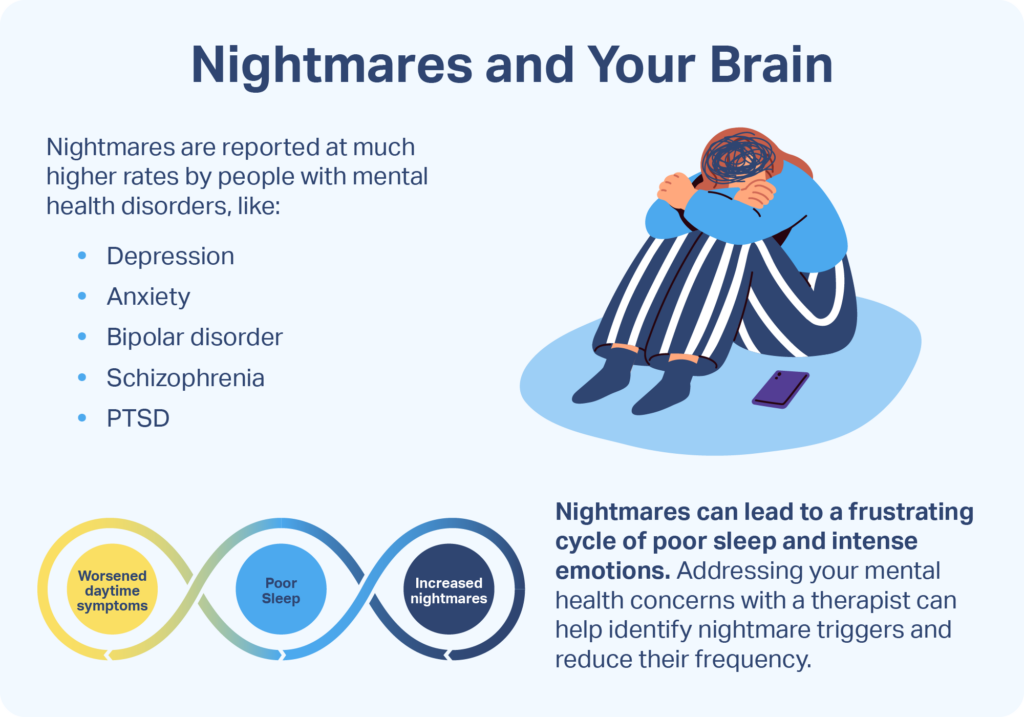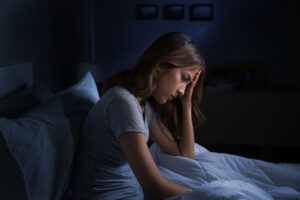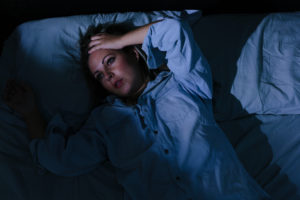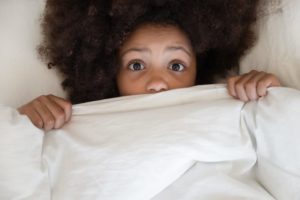How to Stop Having Nightmares
About three-quarters of people experience the occasional nightmare, defined as a disturbing dream that causes the sleeper to wake up.
Bothersome dreams can spark negative feelings such as fear and helplessness. They can also cause sweating, increased heart rate and blood pressure, and other hallmark symptoms of the fight-or-flight response.
In many cases, nightmares are infrequent or go away on their own. However, because recurring nightmares can negatively impact sleep, you might hope to try to prevent them from happening. We examine the factors that can contribute to bad dreams and how to stop having nightmares and get better sleep.
Common Causes of Nightmares
Nightmares usually occur during rapid eye movement (REM) sleep and do not have a single cause. Instead, many different triggers can induce troubling dreams.
- Age: Frequent nightmares are fairly common in childhood. They can start in children who are just a few years old, usually peak during school age , and then often decrease in teenage years.
- Stress: Stress and traumatic experiences are some of the main factors that can cause nightmares for both children and adults. In children, separation anxiety or simply a change in routine can be enough to trigger nightmares. Nightmares may be more common in girls, women, and people assigned female at birth.
- Mental health conditions: Mental health conditions that are linked to nightmares include post-traumatic stress disorder (PTSD), depression, schizophrenia, anxiety and panic disorders, and borderline personality disorder.
- Medication: Certain beta blockers, stimulants, antidepressants, antibiotics, melatonin supplements, and other drugs can contribute to nightmares . Nightmares may also occur after stopping the use of some medications including certain barbiturates, antidepressants, and benzodiazepines.
- Withdrawal: Nightmares can occur after decreasing or stopping the use of alcohol and nicotine . Withdrawal symptoms typically peak within one to three days but may persist longer for some people.
- Eating right before bed: It is believed that eating too close to bedtime may increase the chances of having nightmares.
- Illness: People with a fever are often more susceptible to nightmares.
- Pregnancy: Stress about the baby and upcoming life changes frequently cause vivid dreams and nightmares for pregnant people.
Therapy to Manage Nightmares
Therapy is one of the main ways to address nightmares. Many of the approaches for nightmares are based in cognitive behavioral therapy (CBT) , which is intended to reframe the way a person feels, thinks, and acts to reduce symptoms and improve functioning.
A type of CBT that specifically focuses on sleep-related concerns is called CBT for insomnia (CBT-I). A CBT-I therapist may guide a person to restructure their sleep schedule and restrict negative stimuli in hopes of improving sleep and reducing nightmares.
Depending on the cause of a person’s nightmares, there are multiple methods for using therapy to decrease the chances of having bad dreams.
Psychotherapy For Nightmare Triggers
In nightmare-focused psychotherapy, a mental health professional helps a person work through sources of trauma or mental health issues that may be provoking nightmares. This includes empowering a person with techniques to recognize and address nightmare triggers .
Often, nightmares ease after treating accompanying mental health conditions like PTSD, anxiety, or depression. People who believe that they may have a mental health issue causing nightmares can ask their doctor for a referral to a mental health care provider.
Imagery Rehearsal Therapy for Nightmares
The American Academy of Sleep Medicine recommends using imagery rehearsal therapy as a treatment for nightmare disorder, including nightmares related to PTSD. Image rehearsal therapy aims to reformulate the plot of a recurring dream to make it less disturbing.
Working with a therapist, the sleeper writes down the new and changed plot of the dream and rehearses it during the day. The goal is that the nightmare, if it recurs, will automatically follow the new, more agreeable form.
A related technique called exposure, relaxation, and rescripting therapy (ERRT) builds on image rehearsal therapy by adding progressive muscle relaxation, refinement of sleep habits, and other techniques to complement imagery rehearsal therapy.
Other Types of Therapy for Nightmares
There are many more therapeutic approaches that have been proposed to treat nightmares, but in general these have not been as extensively studied.
- Eye movement desensitization and reprocessing: This therapy is intended to help a person process harmful memories while awake by stimulating the areas in the brain that are active during REM sleep.
- Lucid dreaming therapy: During a lucid dream, the sleeper is aware they are dreaming. Therapists hope that invoking this awareness might help a person change a dream’s storyline when they realize they are having a nightmare.
- Hypnosis: In hypnosis, the therapist induces a state of intense concentration in which a person can try to work through their nightmare trigger.
- Progressive deep muscle relaxation: Working one muscle group at a time, progressive deep muscle relaxation asks the user to tense and then relax successive parts of the body to induce a state of calmness.
- Self-exposure therapy: In a subset of CBT called self-exposure therapy or systematic desensitization, the person intentionally faces the situations that make them anxious, building up from the least to most intense, in hopes of reducing the anxiety they generate.
These therapy techniques involve specific protocols for addressing trauma or anxiety in a controlled way. It is important to always work closely with a mental health professional before starting these therapies and throughout the protocol.

Improving Sleep Hygiene
Sleep hygiene refers to both daytime and nighttime habits that affect sleep. Improving sleep hygiene can promote better sleep and may reduce nightmares. Good habits to adopt include:
- Going to bed and waking up at more or less the same time every day
- Arranging a comfortable bedroom environment
- Using the bedroom only for sleep and being intimate
- Engaging in enjoyable and affirming social interactions
- Getting regular exercise, preferably earlier in the day
- Avoiding heavy meals before bed
- Cutting out alcohol, nicotine, and caffeine in the evening
- Going to the bathroom before bed to reduce the need to wake up to urinate
- Implementing a relaxing bedtime routine
- Turning off or putting away electronic devices while getting ready for bed
Seeking Out Stress Relief
Stress relief may help address a common trigger for nightmares. What works best can vary from person to person but may involve reaching out to trusted friends and family members and making time for self-care activities like exercise, hobbies, and occasional rest periods. Some people find that relaxation techniques, such as yoga, meditation, or listening to music, can reduce stress.

Medication to Reduce Nightmares
In some cases, a doctor may prescribe medication to treat nightmares, including those linked to PTSD. However, the effectiveness of medications for nightmares remains unclear.
Some drugs work by dampening the fight-or-flight response, and research on other types of medication is ongoing.
People interested in medications for nightmares should consult a doctor. Experts generally do not recommend using medication to treat nightmares in children. In addition, anyone who suspects that a medication that they currently take is contributing to nightmares should talk with a doctor before stopping the drug or decreasing its dosage.
Using Technology to Stop Nightmares When They Happen
Nightware is a smartwatch that tracks heart rate and body movements and vibrates when it detects that the sleeper is having a nightmare. In 2020 the Food and Drug Administration (FDA) granted approval for the manufacturer to market Nightware for adults with nightmare disorder or PTSD. The device is only available by prescription.
Although there is limited research on its effectiveness, Nightware provides a low-risk option for managing nightmares that can be used in conjunction with therapy and medications.
In preliminary studies, the smartwatch did not appear to disrupt sleep or cause daytime sleepiness. However, sleepers should always consult a doctor before using Nightware, which may not be appropriate for all people who have nightmares.
How to Help Your Child With Nightmares
If a child is experiencing nightmares, first try soothing them by reminding them that it was just a dream. Children may also find it helpful to describe or draw what they saw in the nightmare so they can talk about it with a trusted adult. As in adults, rescripting or imagery rehearsal therapy while awake may help change the ending of the nightmare so it is less frightening.
It is natural for children to occasionally experience nightmares, but if they happen regularly or cause notable distress, then caregivers should seek advice from a pediatrician.
Children often respond well to having a quiet and dark bedroom, a consistent bedtime, and a screen-free evening routine. To help a child feel safe, spend time with them before bed and offer them a soft toy for comfort. These steps may help reduce stress at night and facilitate nightmare-free sleep.
When to Talk to a Doctor
Consult with a doctor if nightmares occur more than a few times a month or if nightmares are interfering with sleep or other aspects of everyday life. A doctor may be able to identify factors that are contributing to nightmares, such as medications or an untreated mental health condition.
A sleep study is not usually needed for nightmares, but a doctor may suggest a sleep study if a person also has signs of a sleep disorder. For example, if nightmares are related to breathing problems during sleep, a sleep study can diagnose or rule out a sleep-related breathing disorder.
In evaluating any person who experiences nightmares, a health professional often needs to consider whether nightmare disorder or PTSD may be present.
Nightmares vs. Nightmare Disorder
Nightmare disorder involves more than just nightmares that occur every once in a while. Instead, it occurs when frequent nightmares interfere with sleep quality, the ability to fall asleep, or daily life. While occasional nightmares are common, only about 4% of people have nightmare disorder.
Only a health professional can formally diagnose nightmare disorder after carefully reviewing a person’s symptoms. Treating nightmare disorder can help take away the fear of falling asleep and make sleep more refreshing.
PTSD
Nightmares are a central feature of PTSD, a condition involving ongoing symptoms associated with a traumatic event. It is estimated that as many as 80% of people with PTSD have nightmares. Although nightmares typically occur during REM sleep, people with PTSD may experience nightmares when they first fall asleep, often causing insomnia. Many people with PTSD revisit the traumatic event in their dreams or have nightmares based on the feelings surrounding the event.
Children can also have PTSD with nightmares . Whereas adults tend to dream about the trauma itself, children with PTSD may have nightmares about seemingly unrelated events. Still, these ongoing nightmares can make it difficult for children to sleep if they wake up frightened or are scared to fall asleep.
Caregivers of children who have experienced traumatic events can take steps to help the child feel safer. Establishing a daily routine, communicating about the event in an age-appropriate way, limiting exposure to disturbing news broadcasts, and being present with the child may help them recover from the experience. If they are still having trouble coping, a mental health professional can provide additional strategies to help them work through their feelings.

Still have questions? Ask our community!
Join our Sleep Care Community — a trusted hub of sleep health professionals, product specialists, and people just like you. Whether you need expert sleep advice for your insomnia or you’re searching for the perfect mattress, we’ve got you covered. Get personalized guidance from the experts who know sleep best.
References
12 Sources
-
Neuspiel, D. R. & Stubbs, E. H. (2018, August 9). Nightmare disorder. Medscape., Retrieved November 8, 2022, from
https://emedicine.medscape.com/article/914428-overview#showall -
A.D.A.M. Medical Encyclopedia. (2022, June 7). Separation anxiety in children. MedlinePlus., Retrieved November 8, 2022, from
https://medlineplus.gov/ency/article/001542.htm -
Besag, F., Vasey, M. J., Lao, K., & Wong, I. (2019). Adverse events associated with melatonin for the treatment of primary or secondary sleep disorders: A systematic review. CNS Drugs, 33(12), 1167–1186.
https://pubmed.ncbi.nlm.nih.gov/31722088/ -
A.D.A.M. Medical Encyclopedia. (2021, January 17). Alcohol withdrawal. MedlinePlus., Retrieved November 8, 2022, from
https://medlineplus.gov/ency/article/000764.htm -
A.D.A.M. Medical Encyclopedia. (2020, August 13). Nicotine and tobacco. MedlinePlus., Retrieved November 8, 2022, from
https://medlineplus.gov/ency/article/000953.htm -
A.D.A.M. Medical Encyclopedia. (2020, June 2). Problems sleeping during pregnancy. MedlinePlus., Retrieved November 8, 2022, from
https://medlineplus.gov/ency/patientinstructions/000559.htm -
Morgenthaler, T. I., Auerbach, S., Casey, K. R., Kristo, D., Maganti, R., Ramar, K., Zak, R., & Kartje, R. (2018). Position paper for the treatment of nightmare disorder in adults: An American Academy of Sleep Medicine position paper. Journal of Clinical Sleep Medicine, 14(6), 1041–1055.
https://pubmed.ncbi.nlm.nih.gov/29852917 -
Zak, R. & Karippot, A. (2022, November 4). Nightmares and nightmare disorder in adults. In A. Y. Avidan (Ed.). UpToDate., Retrieved November 8, 2022, from
https://www.uptodate.com/contents/nightmares-and-nightmare-disorder-in-adults -
U.S. Food and Drug Administration. (2020, November 6). FDA permits marketing of new device designed to reduce sleep disturbance related to nightmares in certain adults., Retrieved November 8, 2022, from
https://www.fda.gov/news-events/press-announcements/fda-permits-marketing-new-device-designed-reduce-sleep-disturbance-related-nightmares-certain-adults -
Morse, A. M. & Kotagal, S. (2021, October 20). Parasomnias of childhood, including sleepwalking. In L. Wilkie (Ed.). UpToDate., Retrieved November 8, 2022, from
https://www.uptodate.com/contents/parasomnias-of-childhood-including-sleepwalking -
McLaughlin, K. (2022, February 22). Posttraumatic stress disorder in children and adolescents: Epidemiology, pathogenesis, clinical manifestations, course, assessment, and diagnosis. In D. Brent (Ed.). UpToDate., Retrieved November 11, 2022, from
https://www.uptodate.com/contents/posttraumatic-stress-disorder-in-children-and-adolescents-epidemiology-pathogenesis-clinical-manifestations-course-assessment-and-diagnosis?search=nightmares&source=search_result&selectedTitle=9~150&usage_type=default&display_rank=9 -
A.D.A.M. Medical Encyclopedia. (2020, October 2). Traumatic events and children. MedlinePlus., Retrieved November 8, 2022, from
https://medlineplus.gov/ency/patientinstructions/000588.htm




